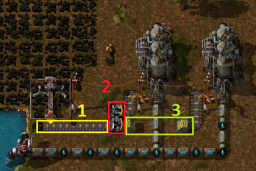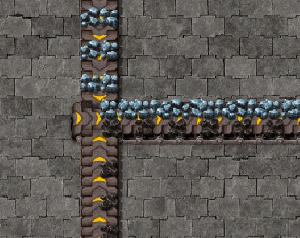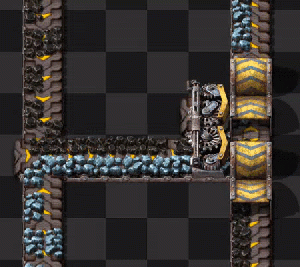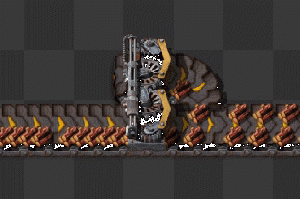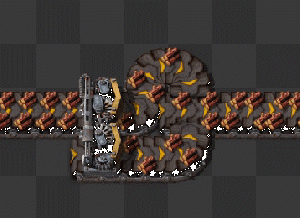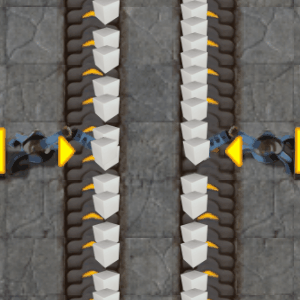Belt transport system: Difference between revisions
| Line 35: | Line 35: | ||
=== Power usage === | === Power usage === | ||
But, like other [[Mysteries of the Factorio World]], this is purely for gameplay reasons. If transport belts needed power, the game would be much more difficult and the player would have to worry about the entire factory coming to a standstill if power was lost. | But, like other [[Mysteries of the Factorio World]], this is purely for gameplay reasons. If transport belts needed power, the game would be much more difficult and the player would have to worry about the entire factory coming to a standstill if power was lost. | ||
Revision as of 10:01, 22 March 2016
The belt transport system is the first transport system available in Factorio, and together with Trains and Logistics Robots make up the backbone of any Factorio base. Transport belts (sometimes called conveyors) are used to transport Items.
Beginner
| Transport belts | Underground belts | Splitters | Speed (tiles/second) | Needed research |
|---|---|---|---|---|
| Basic transport belt | Basic underground belt | Basic splitter | ~1.8 | Logistics 1 Basic underground belt and Basic splitter |
| Fast transport belt | Fast underground belt | Fast splitter | ~3.6 | Logistics 2 |
| Express transport belt | Express underground belt | Express splitter | ~5.6 | Logistics 3 |
Transport belts are just moving items. To take/put items onto a belt use Inserters.
Differences between the belt tiers
The main difference between different tiers of belt is the speed at which they operate. As belt is upgraded from yellow to red to blue, it gets faster and is able to move more items. The Physics page has some technical information on exact values for each tier of transport belt.
Power usage
But, like other Mysteries of the Factorio World, this is purely for gameplay reasons. If transport belts needed power, the game would be much more difficult and the player would have to worry about the entire factory coming to a standstill if power was lost.
For example, if belts needed power, a player might lose the ability to get Coal to their Steam engine. This would mean the player can't generate more power using the steam engine, which means the belts don't bring coal to the engine, etc.
This type of deadlock is avoided by allowing transport belts to operate without power.
Advanced
Merging and un-merging
Belts have two lanes that can be used for transporting. This allows for either a double flow of one material, or with some careful setup, transporting two different materials on the same belt. Mixed belts can be beneficial for smelting ore, or producing items with a lot of ingredients such as the science pack 3. Un-merging a mixed belt is fairly easy too, since an underground belt will block half of your a belt. So there is no reason to be afraid of mixed belts at all.
Balancing belts
Sometimes you will find one side of a belt more empty than the other. In this care rebalancing the belt can be helpful.
The left design only rebalances equally if one side of the belt is empty while the right version always balances equally.
Speed, Density and Throughput: About finding bottlenecks
Maximizing the throughput is important, since it will keep your belts efficient. Therefore we need to introduce some definitions:
- Speed
- How fast does a belt move.
- Density
- How tight are the items put on the belts.
- Throughput
- This is speed * density. It describes how many items pass by in a given time.
So there are two opportunities to enhance the throughput:
- More density
- Sometimes items have little spaces next to each other that aren't big enough for other items to fit in. In this case reordering the items can still increase the density. This can be done by temporary increasing the belt speed on a single tile or by merging 2 lanes with an inserter.
- More speed
- In case your belts already are at maximum density you can still upgrade your speed with better belts. But first you have to find the bottleneck.
The bottleneck can be seen quite easy, if there is a part of a belt, where the items sometimes stop or don't move (or don't move fast) at maximum density and suddenly they come to a point, where this 'stop and go' releases itself and they run free and are not so tight on the belt. This is in most cases the exact place, where you need to optimize your belts.
Debug mode
Belts can be envisioned as "moving ground." Every item on a belt is moved in the belt's direction each tick.
Every item is a small entity with a collision box (to see this, turn on "collision box" in debug mode). When the belt moves, the item (and the item's collision box) moves along with it. When on a belt, item's collision boxes never overlap (see image below).
In the image above, imagine the items moving upward tick by tick. When the items come to the turn, they aren't rotated but are instead moved to the side.
When debug mode is used and the game speed is reduced to around 0.3, the collision boxes of moving items can be clearly seen.
Puzzling game element
Transport belts introduce a puzzle-like game element. The player needs to plan the transport belt system ahead of time, or else risk having to tear them up at a later time when things need to be expanded or moved around. Transport belts have many applications that are not immediately obvious, such as merging belt lanes together, balancing belt lanes, and overcoming logistical challenges such as maximizing throughput while minimizing size.
Many of the pages below include more information on those and other advanced applications of transport belts.
